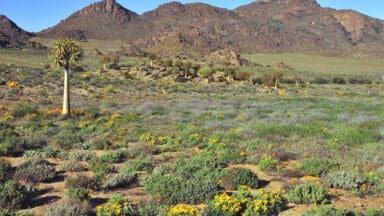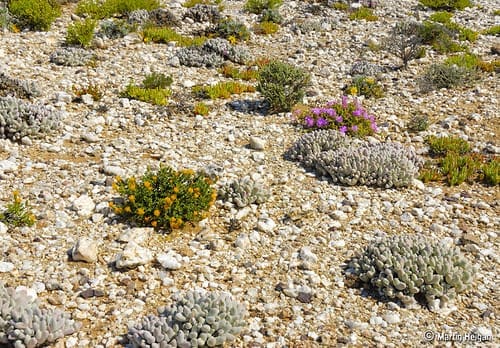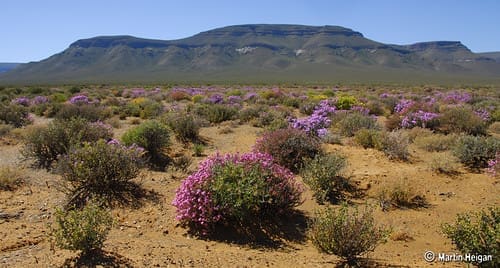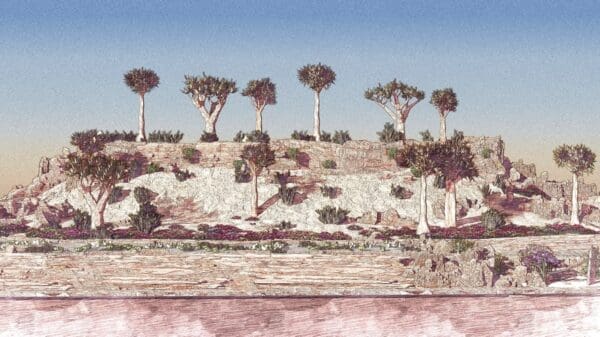
Stretching along the coastal strip of southwestern Namibia and South Africa’s Northern Cape, lies the ecoregion, the Succulent Karoo. A biodiversity hotspot, the Karoo is known for being one of the world’s richest flora of succulent plants, harbouring approximately a third of the world’s 10,000 succulent species.
Designed by Katie Lewis, Estate Architect at the Newt in Somerset, in collaboration with the Master Botanists Ernst van Jaarsveld and Cornell Beukes from the Babylonstoren, the garden will showcase the beauty and resilience of indigenous succulents found in the Karoo, set among rock formations which evoke their natural habitat. Recreating some of the continent’s desert landscapes, the installation will feature rare specimens from 15 plant families, including flora found in Namaqualand in the south-west, to the thicket vegetation of the south Eastern Cape, all of which are part of the Cape Floral Kingdom.
The garden is divided into six key areas, with a colour palette of rich, earthy reds and browns to summon the hues of Karoo. Visitors will experience a ‘quiver tree forest’ on a shale hill, shimmering quartz fields dotted with small, gem-like succulents and the famous butter bush alongside fan aloes. A collection of succulent bulbs will reflect one of the world’s most remarkable, endangered ecosystems.



Highlighting the delicate relationship between varying rock types and how the succulents have adapted to thrive, the garden will feature volcanic, sedimentary and metamorphic stones, with some specimens ranging from 23 million to over one billion years old.
“This garden showcases our vast diversity of succulents. I hope it inspires guests to use rocks and plants to create something beautiful and architectural. It all starts with stone, sincestone begets soil. The better your soil, the better you eat. Most of the smaller succulents are easy to grow at home. One can propagate them by either seed or cuttings,” explained Ernst van Jaarsveld, Master Botanist at Babylonstoren.
The heart of South Africa is immense and mercilessly dry. As the world faces the impact of climate change, we can learn from these small, tenacious succulents which survive in harsh conditions. Resilient, adaptable, easy to grow and good for indoor air quality, these unique specimens could be an appealing choice for urban gardeners.
“Trying to capture the essence of different succulent landscapes and condensing them into one composition had its challenges. We built both scale models and full-scale samples to help our thinking evolve,” explained Katie Lewis, Estate Architect at The Newt in Somerset.
After the show, this garden will be replanted at The Newt in Somerset, bringing a slice of the Karoo landscape to the West Country. The garden will become a new permanent display, with the aim to raise awareness of water-wise plants and endangered species.
The Newt & Babylonstoren
Their fourth year as headline sponsor of the RHS Chelsea Flower Show, the Newt in Somerset is a country estate hotel. The estate comprises of a 2,000 acres arable and livestock farm, along with some 30 acres of formal gardens which draw over 250,000 visitors each year.
“We’re inspired by the work of the RHS. As fellow gardeners, we share a vision: celebrating horticulture for our communities and the planet. Our partnership has thrived over four years as headline sponsor of the RHS Chelsea Flower Show,” explained Andrew Foulkes, CEO of Hospitality, The Newt in Somerset
The Newt’s sister estate, the Babylonstoren is located in the Cape Winelands against the backdrop of the Simonsberg Mountains. Dating back to 1692, the historic fruit and wine farm is best known for its formal garden, designed by French architect Patrice Taravella. The vast garden comprises of vegetable areas, stone and pome fruits, nuts, citrus, berries, bees, herbs, prickly pear maze, and more. Each of the 300 varieties of plants in the garden are edible or has medicinal value.

